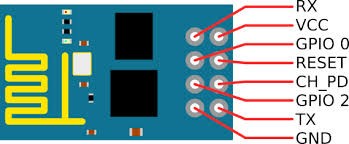ESP8266 wifi module issues I have had

The ESP8266 is very powerful little module, but a very picky one as well. In working with original ESP-01 I had very limited success with it and it just acted "flakey". I do understand now what most of the issues were with this module.
Number one: it likes its groceries! When powering this module or any of the ESP’s do not shortchange it on power. I highly recommend giving it its own 3.3v power source and not using the one supplied with say an Arduino or any other micro controller you maybe using. When the module is underpowered it does strange things that I've said in another blog post. It resets, gives communication issues or just won’t plain work at all. I found giving it it's own 3.3v regulator and/or batteries it functions well.
Next, the pin assignments. When what and where...
The pin usage for module (the ESP-01) are listed in multiple places on the web and is actually easy to hook up to a micro controller with a free serial port.

Pins to connect for using the Wifi module for communication:
- ESP RX —> uC TX
- ESP TX —> uC RX
- ESP Vcc —> It’s own separate power supply.
- ESP Gnd —> uC Gnd AND It’s own separate power supplies Gnd
- ESP CH_PD —> It’s own separate power supplies Vcc
Pins to connect for Flashing new firmware:
- ESP RX —> 3.3v USB serial adaptor TX
- ESP TX —> 3.3v USB serial adaptor RX
- ESP Vcc —> It’s own separate power supply.
- ESP Gnd —> the USB adaptor Gnd AND It’s own separate power supplies Gnd
- ESP CH_PD —> It’s own separate power supplies Vcc
- ESP GPIO0 —> Gnd
What if the module still will not function but seems to power up and have the pretty lights come on? A 8266 like this just may need re-flashing. The best thing to do is get an older firmware to do this, the newer ones may or may not help. The one I re-flashed with can be found here. Download the .bin file and look at the screen shot. Make your Flasher app look the same as it has on the screenine.
After this is filled in click on the operation tab make sure you're comm port is correctly set to your USB adapters comport, then click on the flash button. After a few seconds you should see the AP and STA MAC address fill in. If it doesn't cycle the power on just the ESP 8266 and nothing else. If this doesn't work recheck your wiring and the power supply.
If everything goes okay, the flash progress bar should move and after a short time it should finish. Once this is done remove GPIO0 from ground and power the unit on and off. At this point unit should be set at 9600/8/n/1. you should be able to go in to a terminal program and connect to it via the USB adapter COM address. For this you can pick from any of your favorites like cool term, screen, miniterm or the ESPlorer app.
The flashing will be the same for other modules such as the ESP-201 and ESP-12, but with one more pin to take care of. To flash these units, you will also take GPIO15 to ground, treating it the same way you do GPIO0.
One last issue I have had. The lack of ESP flash utilities for Linux and Mac. I have tried the python tool and one Windows only in Wine, with no success. I do have a dual-booted Linux/Windows machine so, Windows in not a problem for me. I am not saying the other tools do not work, they just did not work for me. I know as the tools and chip matures, things will get better all around. After re-flashing it though, the unit works fine from Mac or Linux from a terminal program like ESPplorer or the like.
In the end, you may get the ESP8266 to work fine with a shared power supply, but from the issues I have had, it works better with it's own.
Thanks for helping to keep our community civil!
This post is an advertisement, or vandalism. It is not useful or relevant to the current topic.
You flagged this as spam. Undo flag.Flag Post


